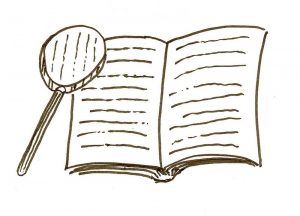In fiction craft, it’s a nearly universal struggle for writers to keep track of their antagonists. (If you don’t struggle with this, count yourself lucky. If you do, never fear! You’re not alone, and I think this will help.)
First, note that keeping track of your antagonist is different from developing your antagonist. Development is related to character, but keeping track—knowing where your antagonist is and what they’re doing and thinking every moment they are not on the page—is related to plot. This is the piece I want to dive into in this two-part article.
Before we can learn strategies that help us keep track of our antagonists, though, we have to know what type of antagonists we have, whether they are the right type of antagonists for our genres, and whether they are the direct cause of major havoc in our heroes’ lives. To that end, here is your assignment for this month:
Identify which type of antagonist you have. Is your antagonist a villain/monster, a force, or an opposition character? In Cast Away, the island (man versus nature) and crushing desolation (man versus self) are the antagonistic forces that drive our hero to act. In Good Will Hunting, the kind, insightful therapist (Robin Williams) is far from a villain or monster, yet he’s the opposition character who forces our troubled protagonist to change for the better. Know which type of antagonist you’ve got behind the wheel of your story’s central conflict.
Evaluate whether your antagonist is genre appropriate. The bulk of “good” (successful, memorable, meaningful, etc.) stories, regardless of genre, have both an internal/thematic/growth arc and an external/action arc. (The idea that all stories can be classified as either “character-driven” or “plot-driven” is poppycock.) The opposition your hero experiences in these two realms may or may not be embodied by different antagonists. Regardless, let your genre tell you which antagonist should get more energy in your story.
For example, the hero of a police procedural is trying to catch a criminal (the antagonist of the external/action arc), but he’s also getting flack from his captain, who keeps telling him he needs to straighten up and play by the rules (the antagonist of the internal/thematic/growth arc). Which antagonist are thriller readers more interested in? It ain’t the captain! So give the criminal more energy, regardless of whether you give the criminal a point of view. (We’ll discuss multi-POV stories that give voice to our antagonists next month, in Part II.)
In a romance, the love interests serve as opposition characters for each other’s internal/thematic/growth arcs, which are of greater interest to the reader. The antagonist of a romance’s external/action arc (like the heartless land developer who intends to raze the beloved small-town inn our love interests have a stake in saving) is not the antagonist readers showed up to watch. So give the opposition moments between the two love interests more energy.
Know your genre, and know whether the antagonist to whom you’ve given the most energy in your manuscript is the one that will satisfy your genre’s readers.
Analyze the top five scenes in your manuscript in which your hero is the most unsettled. What is the source of that tension, fear, anxiety, uncertainty, sorrow, regret, anger, etc.? Directly or indirectly, it had better be something an antagonist said or did. If your protagonist is repeatedly experiencing all sorts of intense feelings as a result of circumstances they were powerless to prevent (an electrical house fire, a cheating spouse, the decline of a parent’s health, the loss of a job due to downsizing, etc.), then you are probably still trying to figure out what your story is. Or if you even have a story. That’s because while a life-changing event makes for a serviceable plot catalyst or inciting incident, heaping circumstantial suffering on a character for three hundred pages is not story. Story happens when compelling, motivated opposition happens—and compelling, motivated opposition is exactly what antagonists in fiction exist to provide.
What’s next? Once you’ve worked through these three things related to your story, you’ll be ready for Part II (coming in January): techniques for keeping track of your antagonist. Knowing what your antagonist is up to behind the scenes will, as a matter of course, amp up your story’s tension; make your conflict more believable and immediate; keep your protagonist on their toes and force them to react in compelling ways; and raise the stakes. See you next month!
Creative Commons Photo Credit: Tall Chris
Tags: antagonists, opposition characters, pantsing, plot, plotting, villains
